Variations of Turbidity (Ntu) and Suspended Solid Concentrations (Ssc) In Elemi River, Ado-Ekiti, Nigeria - Juniper Publishers
Juniper Publishers- Open Access Journal of Environmental Sciences & Natural Resources
Variations of Turbidity (Ntu) and Suspended Solid Concentrations (Ssc) In Elemi River, Ado-Ekiti, Nigeria
Authored by OP Folorunso
Abstract
Changes in contaminant concentration in rivers can be a function of time and location. Seasonal changes greatly influence the parameters of water bodies, which in turn changes the water quality characteristics. Monitoring sites during different periods of time can render information about water quality trends. In this paper, the turbidity and suspended solid concentration (SSC) of selected locations in river Elemi are examined for temporal variations. The turbidity levels at the locations exceeded the water quality standards, addressing this requires understanding the SSC which drives the turbidity in the river. Turbidity and SSC were correlated; turbidity increased exponentially with SSC, hence showing positive trends in all the examined locations. The results indicate occurrence of high level of turbidity and SSC in June and July (period of high discharge and runoff). The result provides information requires monitoring both SSC and turbidity (NTU) within the reaches of the river.
Keywords: Suspended solids; Turbidity; Temporal and Spatial variations; Elemi; River
Introduction
The effect of erosion degradation, negative influences of toxic pollution and human activities all threaten the water quality. Turbidity and total suspended solids refer to particles present in the water column. Turbidity and water clarity are both visual properties of water based on light scattering and attenuation. All three parameters are related to particles in the water column, whether directly or indirectly. Turbidity is determined by the amount of light scattered off of these particles [1]. While this measurement can then be used as surrogate to estimate the suspended solid concentration SSC. Turbidity does not include any settled solids or bed-load (sediment that "rolls" along the riverbed). In addition, turbidity measurements may be affected by colour dissolved organic matter. While this dissolved matter is not included in SSC measurements, it can cause artificially low turbidity readings as it absorbs light instead of scattering it. SSC is a specific measurement of all suspended solids, organic and inorganic by mass. SSC includes settle able solids, and is the direct measurement of total solids present in a water body. As such, SSC can be used to calculate sedimentation rates. Turbidity and SSC are the most visible indicators of water quality. These suspended particles can come from soil erosion, runoff, discharges, stirred bottom sediments or algal blooms. While it is possible for some streams to have naturally high levels of suspended solids, clear water is usually considered an indicator of healthy water. A sudden increase in turbidity in a previously clear body of water is a cause for concern. Excessive suspended sediment can impair water quality for aquatic and human life, impede navigation and increase flooding risks [2]. Monitoring operative of rivers indicate time and seasonal change in water turbidity. Some rivers have good water clarity in dry season but become turbid in wet season with temporal and spatial variations of turbidity within the river reaches. Monitoring and analyzing this water turbidity variation can help in decision making for river management [3-10].
Materials and Methods
Three sets of samples were taken from three locations 1.5m apart on Elemi River at a distance of 5m from the river bank. The three sets of samples were collected at the same point at different days of 8 June 2016, 20 June 2016, 14 July 2016, 30 July 2016, 8 August 2016, and 12 August 2016. Samples collected into a tight closed container were preserved in order to have samples of good representation for the different types of analysis to be carried out on them. Water samples were collected by the combinations of grab, continuous and composite water sampling methods. The grab sampling was used to collect water with a container from the water source, while continuous water sampling occasionally deployed (due to cost) to pump out the water continuously where the grab method application was difficult and the composite involves mixing together all the collected water samples per location for average quality water samples. Collected samples were taken to the laboratory for turbidity and suspended solid concentration measurements. Turbidity was measured by the amount of light scattered at angle 90 degree to the incident beam using a calibrated turbidity meter in standard 4000 NTU solution and SSC was measured using filtration method in line with the American Society for Testing and Materials [11-16].
Results and Discussion
The turbidity and SSC show temporal variations for the three locations examined in river Elemi. From (Figures 1-6) the SSC and turbidity relationship indicate positive relationship between SSC and turbidity for all the days measured. On June 8 (Table 1) location 2 recorded the highest value of 15.98mg/l and 8.90NTU for SSC and turbidity respectively and least value of 14.20mg/l and 7.52NTU for SSC and turbidity were recorded in location 3. SSC and turbidity value increases in location 3 with 13.89mg/l, 7.78NTU and geometrically decreases in locations 1 (13.45mg/l, 7.30NTU) and 2 (12.11mg/l; 6.96NTU) respectively on June 20. The SSC value increases with turbidity in location 2 (11.98mg/l, 6.96NTU) and decreases in locations 3 (11.23mg/l, 5.69NTU) and 1 (10.98mg/l, 6.54NTU) for July 14. On July 30, the SSC value increases with turbidity in location 1 (10.52mg/l and 5.85NTU) and 2 (10.22mg/l, 5.55NTU) and decreases in location 3 (9.86mg/l, 4.89NTU). On August 8, the SSC and Turbidity values generally decrease relative to the previous days. SSC value increased with turbidity in location 2 (9.50mg/l, 5.08NTU) and 1 (8.02mg/l, 4.45NTU) and decreases in location 3 (7.54mg/l and 3.67NTU).
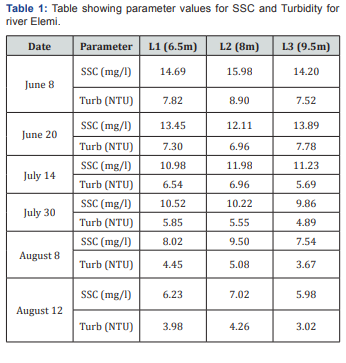
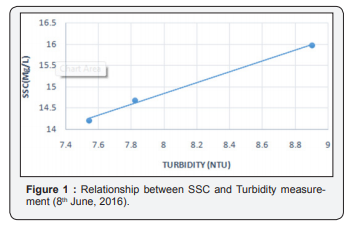
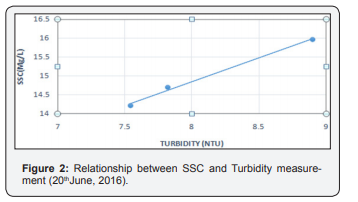
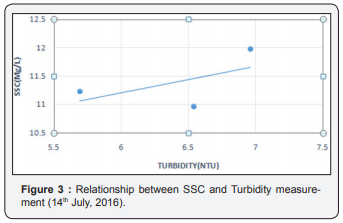
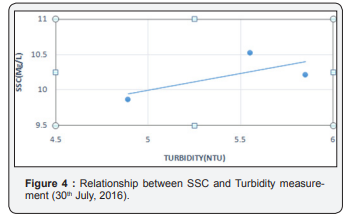
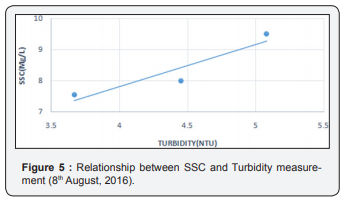
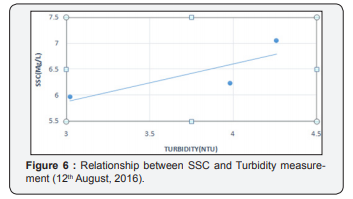
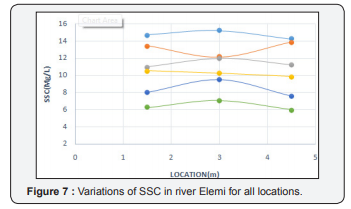
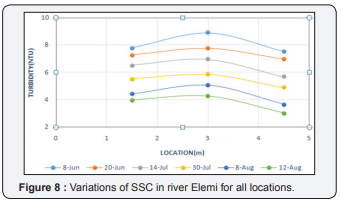
The relatively least values of SSC and turbidity was recorded in August 12.SSC values increased with turbidity in location 2 (7.07mg/l, 4.26NTU) and 1 (6.23mg/l and 3.98NTU) with least value of 5.98mg/l and 3.02NTU recorded in location 3 for August 12. (Figure 7) shows both temporal and spatial variations of suspended solid concentration for all the days measured. The distribution of SSC as inferred from the figure shows similar trend except for June 20 at location 1, 2, 3 and July 30 at locations 1 and 2, the highest value of SSC was recorded on June 8 at location 2 and the lowest SSC recorded in August 12 at location 3. The result demonstrates a reduction in SSC with time at river Elemi. Similarly, (Figure 8) shows the comparative distribution of turbidity for the days measured, the turbidity measures shows similar trends with the SSC, the highest value of turbidity was recorded in June 8 at location 2 while the lowest value of turbidity was recorded in August 12 in location 3.The increase in turbidity and SSC value in June and July is attributed to high rain event with high discharge and runoff which aid resuspension of sediment particle [17-22].
Conclusion
Higher values of SSC and turbidity were recorded in June and July due to high rain event with higher discharge to resuspend the sediment particles, and the lower value of the parameters recorded in August due to a reduced rainfall event and lower runoff. The amount of SSC and Turbidity is the key issue that affects river water quality. World Health Organization (2006) recommends that turbidity of drinking water should have less than 5NTU, preferably less than 1 NTU and ideally below 0. 1.NTU; therefore the river is not recommended for drinking during high rainfall event.
To know more about Juniper Publishers please click on: https://juniperpublishers.com/manuscript-guidelines.php
For more articles in Open Access Journal of Environmental Sciences & Natural Resources please click on: https://juniperpublishers.com/ijesnr/index.php



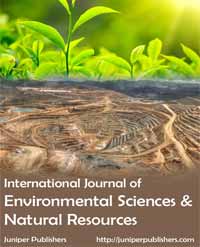
Comments
Post a Comment